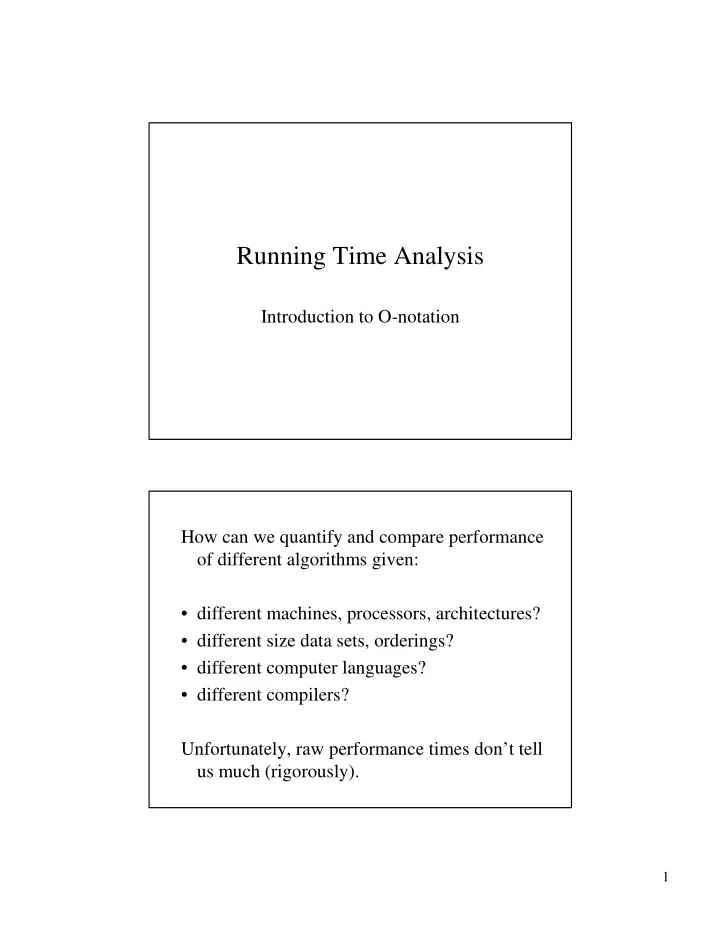

Running Time Analysis Introduction to O-notation How can we quantify and compare performance of different algorithms given: • different machines, processors, architectures? • different size data sets, orderings? • different computer languages? • different compilers? Unfortunately, raw performance times don’t tell us much (rigorously). 1
Possible Approaches • Benchmarks -- test data or test programs that are designed to help us quantitatively evaluate performance. • O-notation (Big-O) Quantify and compare performance of different algorithms that is independent of: • machine, processor, architecture • size of data sets, ordering of data • computer language • compiler used 2
void guess_game(int n) { int guess; char answer; assert(n >= 1); cout << “Think of a number between 1 and ” << n << “.\n”; answer = ‘N’; for(guess = n; guess > 0 and answer != ‘Y’ and answer != ‘y’;--guess) { cout << “Is your number ” << guess << “?” << endl; cout << “Please answer Y or N, and press return:”; cin >> answer; } if(answer == ‘Y’ or answer == ‘y’) cout << “Got it :) \n”; else cout << “I think you are cheating :( \n”; } Algorithm Performance • Worst case performance? • Best case performance? • Average case performance? 3
Algorithm Performance • Worst case performance: loops n times!! • Best case performance? • Average case performance? Algorithm Performance • Worst case performance: loops n times!! • Best case performance: loops once. • Average case performance? 4
Algorithm Performance • Worst case performance: loops n times!! • Best case performance: loops once. • Average case performance: – assume: all answers between 1 and n are equally likely. – average case n n 1 1 ∑ = + + + + = i n ( 1 2 3 ... ) n n 2 i = 1 void guess_game(int n) { int guess; char answer; assert(n >= 1); 1 1 cout << “Think of a number between 1 and ” << n << “.\n”; answer = ‘N’; 1 2n+2 for(guess = n; guess > 0 and answer != ‘Y’ and answer != ‘y’;--guess) { n cout << “Is your number ” << guess << “?” << endl; n cout << “Please answer Y or N, and press return:”; n cin >> answer; } if(answer == ‘Y’ or answer == ‘y’) 1 cout << “Got it :) \n”; 1 else cout << “I think you are cheating :( \n”; 1 } Total: f(n) = 5n + 7 5
Computation required as function of n • What is the total number of operations needed in guess_game? • The number of operations required is a linear function of n: f(n) = c + kn. • As n increases, computation required increases linearly. We say it is O(n). Why Simplify? • As n gets bigger, highest order term dominates. • Take for instance = + + f n n n 2 ( ) 5 4 20 • then when n = 2000, the square term accounts for more than 99% of running time!! 6
Examples = + + + f n n n n 4 2 ( ) 2 9 7 6 2 log = + + f n n n n c 2 ( ) = + − f n n n n n ( ) log ( 1 ) = n + + f n n n n 20 ( ) 2 log Examples = + + + → f n n n n O n 4 2 4 ( ) 2 9 7 6 ( ) = + + → f n n n n c O n n 2 2 2 ( ) log ( log ) = + − → f n n n n n O n 2 ( ) log ( 1 ) ( ) n n = + + → f n n n n O 20 ( ) 2 log ( 2 ) 7
Intuition scale Adjective O-notation of constant O(1) strength logarithmic O(logn) linear O(n) nlogn O(nlogn) quadratic O(n 2 ) cubic O(n 3 ) O(2 n ), O(10 n ), etc. exponential Intuition scale Example O-notation of constant O(1) strength binary search O(logn) scale vector O(n) O(n 2 ) vector, matrix multiply matrix, matrix multiply O(n 3 ) 8
Running time for algorithm f(n) n=256 n=1024 n=1,048,576 1 µ sec 1 µ sec 1 µ sec 1 8 µ sec 10 µ sec 20 µ sec log 2 n 256 µ sec n 1.02ms 1.05sec n log 2 n 2.05ms 10.2ms 21sec n 2 65.5ms 1.05sec 1.8wks n 3 16.8sec 17.9min 36,559yrs 2 n 3.7x10 63 yrs 5.7x10 294 yrs 2.1x10 315639 yrs Largest problem that can be solved if Time <= T at 1 µ sec per step f(n) T=1min T=1hr T=1wk T=1yr � 10 7 � 10 9 � 10 11 � 10 13 n 6 3.6 6 3.2 � 10 6 � 10 8 � 10 10 � 10 11 nlogn 2.8 1.3 1.8 8 � 10 3 � 10 4 � 10 5 � 10 6 n 2 7.8 6 7.8 5.6 � 10 2 � 10 3 � 10 3 � 10 4 n 3 3.9 1.5 8.5 3.2 2 n 25 31 39 44 9
Warning: Some algorithms do not always take the same amount of time for problems of a given size n. Worst case performance vs. Average case performance In general, best case performance is not a good measure. Formal Definition We say f(n) is O(g(n)) if there exist two positive constants k and n 0 such that |f(n)| <= k|g(n)| for all n>= n 0 The total number of steps does not exceed g(n)*constant provided we deal with sufficiently large problems (large n). 10
Recommend
More recommend